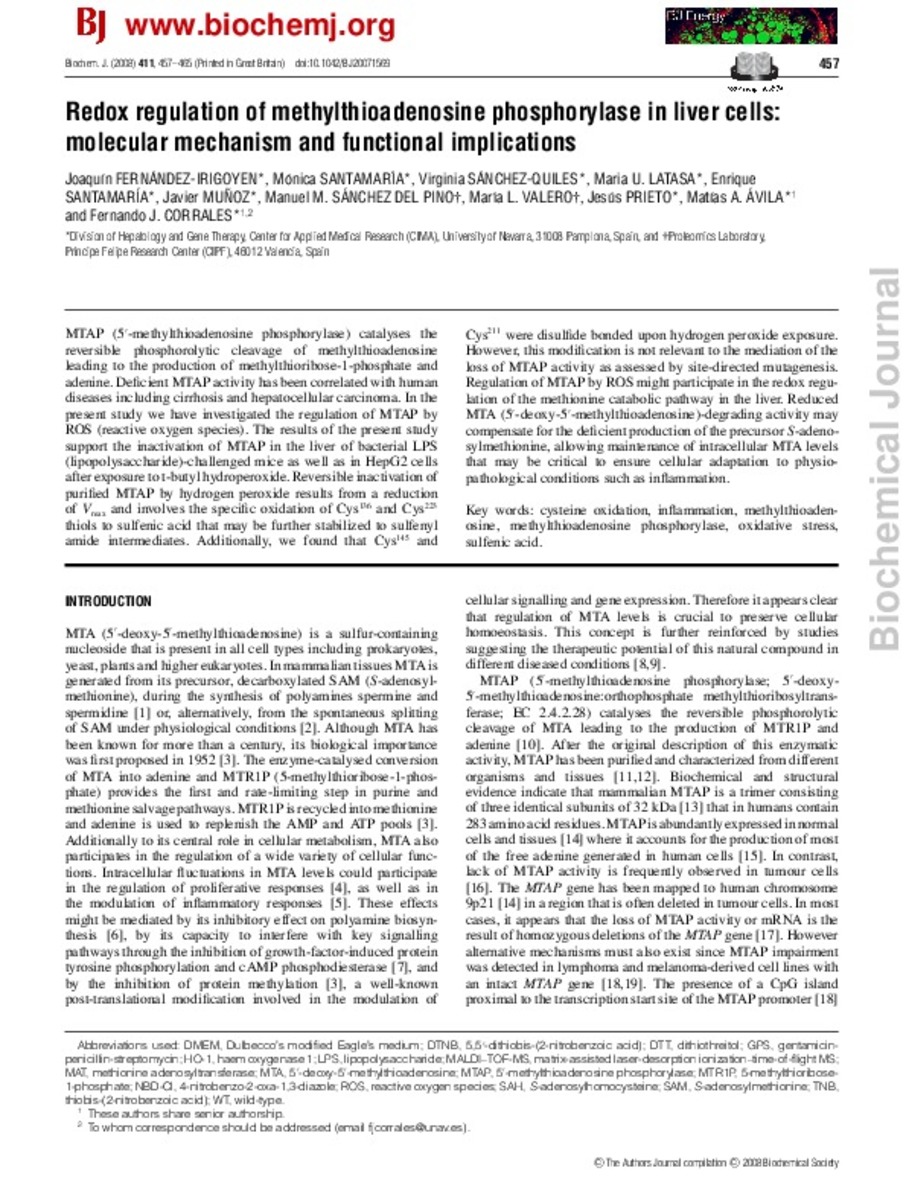Full metadata record
| DC Field | Value | Language |
|---|---|---|
| dc.creator | Fernandez-Irigoyen, J. (Joaquín) | - |
| dc.creator | Santamaria, M. (Mónica) | - |
| dc.creator | Sanchez-Quiles, V. (Virginia) | - |
| dc.creator | Latasa, M.U. (María Ujué) | - |
| dc.creator | Santamaria, E. (Enrique) | - |
| dc.creator | Muñoz, J. (Javier) | - |
| dc.creator | Sanchez-del-Pino, M.M. (Manuel M.) | - |
| dc.creator | Valero, M.L. (María L.) | - |
| dc.creator | Prieto, J. (Jesús) | - |
| dc.creator | Avila, M.A. (Matías Antonio) | - |
| dc.creator | Corrales, F.J. (Fernando José) | - |
| dc.date.accessioned | 2012-03-29T13:58:39Z | - |
| dc.date.available | 2012-03-29T13:58:39Z | - |
| dc.date.issued | 2008 | - |
| dc.identifier.citation | Fernandez-Irigoyen J, Santamaria M, Sanchez-Quiles V, Latasa MU, Santamaria E, Munoz J, et al. Redox regulation of methylthioadenosine phosphorylase in liver cells: molecular mechanism and functional implications. Biochem J 2008 Apr 15;411(2):457-465. | es_ES |
| dc.identifier.issn | 1470-8728 | - |
| dc.identifier.uri | https://hdl.handle.net/10171/21417 | - |
| dc.description.abstract | MTAP (5'-methylthioadenosine phosphorylase) catalyses the reversible phosphorolytic cleavage of methylthioadenosine leading to the production of methylthioribose-1-phosphate and adenine. Deficient MTAP activity has been correlated with human diseases including cirrhosis and hepatocellular carcinoma. In the present study we have investigated the regulation of MTAP by ROS (reactive oxygen species). The results of the present study support the inactivation of MTAP in the liver of bacterial LPS (lipopolysaccharide)-challenged mice as well as in HepG2 cells after exposure to t-butyl hydroperoxide. Reversible inactivation of purified MTAP by hydrogen peroxide results from a reduction of V(max) and involves the specific oxidation of Cys(136) and Cys(223) thiols to sulfenic acid that may be further stabilized to sulfenyl amide intermediates. Additionally, we found that Cys(145) and Cys(211) were disulfide bonded upon hydrogen peroxide exposure. However, this modification is not relevant to the mediation of the loss of MTAP activity as assessed by site-directed mutagenesis. Regulation of MTAP by ROS might participate in the redox regulation of the methionine catabolic pathway in the liver. Reduced MTA (5'-deoxy-5'-methylthioadenosine)-degrading activity may compensate for the deficient production of the precursor S-adenosylmethionine, allowing maintenance of intracellular MTA levels that may be critical to ensure cellular adaptation to physiopathological conditions such as inflammation. | es_ES |
| dc.language.iso | eng | es_ES |
| dc.publisher | Portland Press | es_ES |
| dc.relation | info:eu-repo/grantAgreement/NIH/NATIONAL_CENTER_FOR_COMPLEMENTARY_&_INTEGRATIVE_HEALTH/5R01AT001576-13/US | - |
| dc.rights | info:eu-repo/semantics/openAccess | es_ES |
| dc.subject | Cysteine oxidation, | es_ES |
| dc.subject | Inflammatio | es_ES |
| dc.subject | Methylthioadenosine | es_ES |
| dc.subject | Methylthioadenosine phosphorylase | es_ES |
| dc.subject | Oxidative stress | es_ES |
| dc.subject | Sulfenic acid | es_ES |
| dc.title | Redox regulation of methylthioadenosine phosphorylase in liver cells: molecular mechanism and functional implications | es_ES |
| dc.type | info:eu-repo/semantics/article | es_ES |
| dc.relation.publisherversion | http://www.biochemj.org/bj/411/0457/bj4110457.htm | es_ES |
| dc.type.driver | info:eu-repo/semantics/article | es_ES |
Files in This Item:
Statistics and impact
Items in Dadun are protected by copyright, with all rights reserved, unless otherwise indicated.






